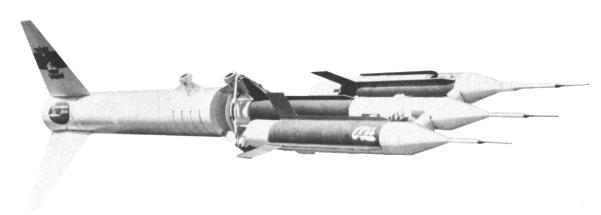Cook Cree
The Cree research missile was built by Cook Research Laboratories, and was used in the 1958/59 time frame by the USAF's Wright Air Development Center to test high-speed parachute recovery systems for missiles, drones, and re-entering spacecraft.
 |
| Photo: via Ordway/Wakeford |
| Cree |
The Cree consisted of a large solid-propellant spin-stabilized rocket booster carrying three smaller test vehicles to speed and altitude. After booster burnout, the test vehicles separated and continued to coast about 9 m (30 ft) apart. Shortly after separation, the test parachutes were ejected from the tails, and the action was recorded by on-board cameras. About 30 seconds after test parachute deployment, a large parachute was released by each test vehicle for safe recovery of the recorded film. During the flight, a telemetry downlink relayed data on the missiles' speed, altitude and temperature. The Cree could test parachute systems at speeds between 2450 km/h (1520 mph) and 4890 km/h (3040 mph), and at altitudes between 8 km (5 miles) and 45 km (28 miles).
Specifications
Note: Data given by several sources show slight variations. Figures given below may therefore be inaccurate!
Data for Cree:
| Weight | 520 kg (1150 lb) |
| Speed | 4890 km/h (3040 mph) |
| Altitude | 45 km (28 miles) |
| Propulsion | Solid-fueled rocket |
Main Sources
[1] Frederick I. Ordway III, Ronald C. Wakeford: "International Missile and Spacecraft Guide", McGraw-Hill, 1960
[2] Norman J. Bowman: "The Handbook of Rockets and Guided Missiles", Perastadion Press, 1963
Back to Directory of U.S. Military Rockets and Missiles, Appendix 4
Last Updated: 20 October 2003